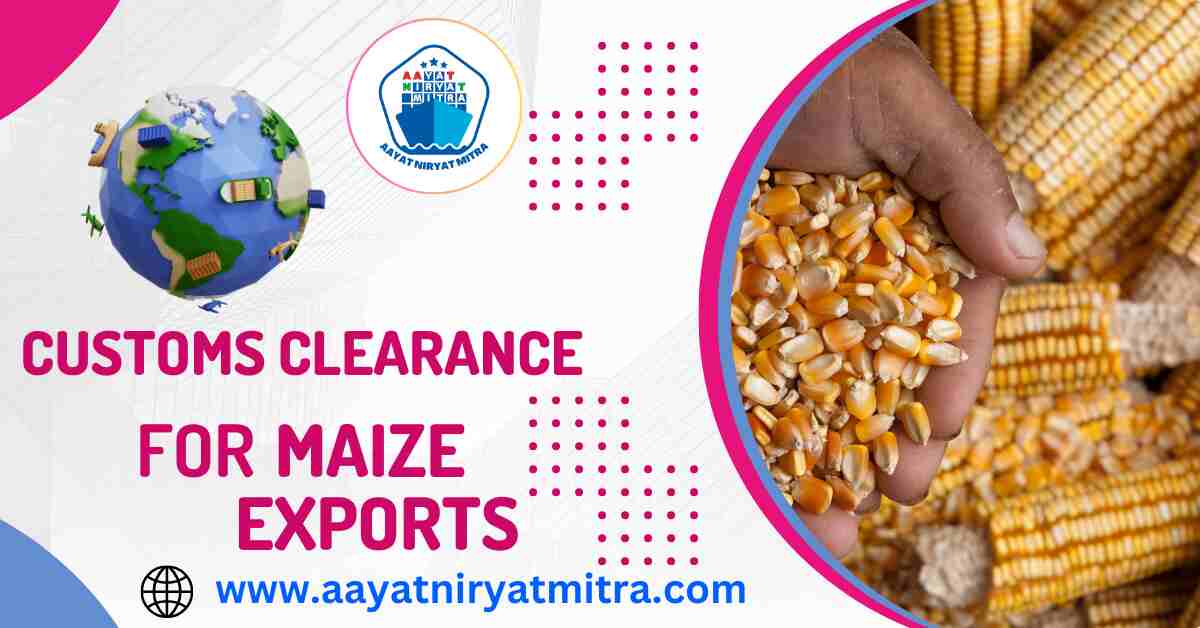Exporting maize, also known as corn, is a profitable venture that provides access to global markets. However, maize exports come with their own set of challenges—especially when it comes to customs clearance. Properly understanding the procedures and complying with international and local regulations are critical to ensuring a smooth and efficient export process. This comprehensive guide will walk you through the steps involved in navigating customs clearance for maize exports.
What is Customs Clearance?:
Customs clearance is the official process required to obtain government approval for importing or exporting goods. It involves submitting essential documents, calculating and paying duties, and ensuring compliance with country-specific regulations. When exporting maize, these steps can become complex due to the agricultural nature of the product, making it crucial to adhere to strict guidelines and regulatory standards.
Key Steps in Maize Export Customs Clearance:
Successfully clearing customs for maize exports requires careful preparation. Let’s explain the necessary actions that you must use:
1. Pre-Shipment Documentation:
Before your maize shipment is even loaded, ensure that the necessary documents are prepared and accurate. These documents form the backbone of the customs clearance process.
- Commercial Invoice: This document details the maize product, its quantity, value, and buyer information. It’s crucial to include clear descriptions of the maize, along with price and terms of sale.
- Packing List: This outlines the contents of each package, including weight, dimensions, and markings. Customs officials rely on this list to verify the shipment contents.
- Bill of Lading: Issued by the shipping company, the bill of lading serves as both a receipt of cargo and a contract of carriage. It also confirms the ownership of the maize shipment.
- Phytosanitary Certificate: This document is critical for agricultural exports like maize. It certifies that the maize is free from pests and diseases, meeting the importing country’s health standards.
- Certificate of Origin: This verifies the country where the maize was grown. It may affect duties and tariffs depending on trade agreements between countries.
- Import Permit (of the Importing Country): Some countries require an import permit for maize. Check the import regulations of the destination country to ensure compliance.
2. Customs Filing:
Once the documentation is ready, the next step is submitting the required customs filings.
- Assign the Right Customs Code: It’s vital to use the correct Harmonized System (HS) code for maize. This code is used globally to classify traded products and determine applicable tariffs and regulations.
- Prepare a Customs Declaration: This document provides detailed information about the shipment, including product description, value, and quantity. Accuracy is key, as errors can result in costly delays.
- Submit the Required Documents: Send all necessary documents, including the customs declaration, to the appropriate customs authorities for review.
3. Customs Inspection:
Customs officials may choose to inspect your shipment to verify that it matches the documentation.
- Physical Examination: Customs agents may physically inspect the maize shipment to ensure that the declared information aligns with the actual cargo.
- Document Verification: Officials will thoroughly check your submitted documents to ensure they meet the required standards.
4. Duty Payment:
One of the final steps in the customs clearance process is calculating and paying any applicable duties.
- Calculate Customs Duties: The duties owed will depend on the HS code, the value of the maize, and the import regulations of the destination country.
- Pay the Duties: Customs duties must be paid before the shipment is allowed to proceed. To avoid any delays, make sure to pay on time.
5. Shipment Release:
Once all the customs formalities have been completed, your maize shipment can be cleared for export.
- Receive Customs Clearance Approval: After meeting all requirements and paying the necessary duties, customs officials will issue a clearance permit.
- Release of Goods: With the clearance permit in hand, your maize shipment can be released and transported to its final destination.
Common Challenges in Maize Export Customs Clearance (and How to Solve Them):
Even with careful preparation, exporting maize can come with its fair share of challenges. Here are some common hurdles exporters face and how to overcome them:
- Documentation Errors: Ensure that all documents are filled out accurately and completely. Even minor errors can result in delays or fines.
- Tariff Classifications: Using the wrong HS code can result in incorrect duty assessments. Work with an experienced customs broker to ensure proper classification.
- Phytosanitary Issues: Agricultural products are heavily regulated. Make sure your maize meets all phytosanitary requirements to avoid rejection at the border.
- Trade Restrictions: Stay updated on any changes to trade agreements or import/export regulations that could affect your maize shipment.
Tips for Smooth Customs Clearance:
Navigating customs can be complex, but these tips can help you streamline the process:
- Hire a Customs Broker: A customs broker can help you navigate the complexities of international trade and customs regulations, ensuring that your shipment clears customs without issue.
- Build Strong Relationships: Establish good working relationships with customs officials, freight forwarders, and logistics partners. This can help you resolve issues more quickly when they arise.
- Leverage Technology: Many countries offer customs automation systems that allow you to submit documents electronically and track your shipment in real-time.
- Stay Compliant: Keep up with changes in customs regulations and industry best practices. Compliance will save you time, money, and frustration in the long run.
Resources for Indian Exporters:
- Ministry of Commerce and Industry, India
- Federation of Indian Export Organisations (FIEO)
- Export Credit Guarantee Corporation (ECGC)
- Indian Trade Promotion Organisation (ITPO)
- Embassy and Consulates of India in African countries
FAQs On Customs Clearance for Maize Exports:
-
Q: What are the Primary Documents Required for Customs Clearance of Maize Exports?
Ans: To clear customs when exporting maize, you’ll need to prepare several key documents: the invoice, packing list, bill of lading, certificate of origin, phytosanitary certificate, and possibly an export license if applicable. Additionally, be sure to include any specific certificates or permits required by the importing country.
-
Q: What Regulations and Standards Must Maize Exports Meet for Customs Clearance?
Ans: Maize exports must comply with a range of regulations, including food safety standards, phytosanitary regulations, and quality standards. Some countries may also impose specific quarantine measures or restrictions, so it’s important to check the importing country’s requirements.
-
Q: How Can I Determine the Tariffs and Duties for Maize Exports to a Specific Country?
Ans: To find out the applicable tariffs and duties, you can consult the customs tariff schedule of the importing country. Alternatively, a customs broker or trade expert can provide guidance.
-
Q: What Role Does a Customs Broker Play in the Maize Export Process?
Ans: A customs broker can be invaluable in navigating the complex customs procedures. They help ensure that your shipment complies with all regulations and can expedite the clearance process, saving you time and potential headaches.
-
Q: What are Common Challenges During Customs Clearance of Maize Exports?
Ans: Exporting maize can come with a few challenges, such as delays due to documentation errors, inspections, quarantine measures, tariff disputes, or sudden changes in regulations. You can better handle these obstacles if you are prepared.
-
Q: How Can I Prepare for Potential Customs Inspections of Maize Exports?
Ans: To be ready for customs inspections, make sure all your documentation is accurate and complete, and that your maize meets all required regulations. It’s also wise to be prepared to provide additional information or samples if requested by customs officials.
-
Q: What are the Differences in Customs Clearance for Organic vs. Non-Organic Maize Exports?
Ans: If you’re exporting organic maize, you’ll likely need additional certifications, such as an organic certification from a recognized body. Organic maize might also be subject to different regulations or tariffs compared to non-organic maize.
-
Q: Are There Specific Quarantine Measures or Restrictions for Maize Exports to Certain Countries?
Ans: Yes, some countries have specific quarantine measures, such as fumigation requirements or quarantine periods. Always check the importing country’s regulations to ensure compliance.
-
Q: How Can I Obtain the Necessary Export Licenses and Permits for Maize Exports?
Ans: To get the necessary licenses and permits, you’ll need to contact the relevant government agencies in your country. They can guide you through the application process and inform you of the requirements.
-
Q: What are the Best Practices for Ensuring Smooth Customs Clearance of Maize Exports?
Ans: The key to smooth customs clearance is to plan ahead. Make sure all your documentation is accurate, comply with the regulations, and consider hiring a reputable customs broker if needed. Staying updated on any changes in customs procedures or regulations is also crucial to avoid any surprises.
Conclusion:
Successfully exporting maize requires more than just growing and packaging the product. Understanding and navigating the customs clearance process is critical to ensure that your maize reaches international markets without delay. By preparing the right documentation, complying with phytosanitary requirements, and staying up-to-date with international trade regulations, you can make the customs clearance process smooth and efficient. Happy exporting!
If you discover an error in the “Navigating Customs Clearance for Maize Exports: A Comprehensive Guide in 2025“ information provided to us, please notify us immediately via the comment box and email; if the information provided by you is correct, We will change it.
If you enjoyed this article, please share it with your friends. Please visit Aayat Niryat Mitra | Import Export Friend for more information on this and other topics. Thank you for stopping by.

